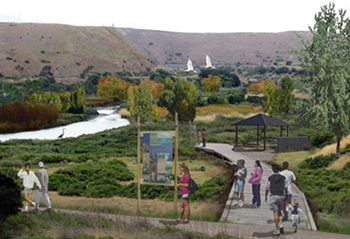Blueprint Jordan River: A Lake-to-Lake Vision

Vision of a nature preserve and public trail from the Blueprint Jordan River plan. (Courtesy of Envision Utah)
Coalition for Utah’s Future/Project 2020
Project Goals
The goal of the Blueprint Jordan River grant project was to develop a collective vision for the Jordan River corridor that integrated transportation planning and natural resource restoration. The project team collaborated with the community, local government, and State and Federal agencies to carry out the grant project. As a result of the collaboration, the project team, coordinated by the public-private partnership Envision Utah, produced the Blueprint Jordan River vision document to guide development and restoration along the Jordan River.
Project Accomplishments
Envision Utah worked with planners, local government representatives, community members, and non-government organizations in Salt Lake and Utah counties to lead the Blueprint Jordan River visioning process. Once the Blueprint document was complete, Envision Utah helped Salt Lake County establish an interim planning committee, which led to the formation of the Jordan River Commission in August 2010. Through an interlocal agreement, 17 cities, counties, transportation agencies, and other local and State agencies serve as Commission members. A Technical Advisory Committee (TAC) helps guide the Commission’s decisionmaking on funding projects to implement the Blueprint vision. The TAC provides a technical review and recommendations for all significant proposed projects within a one-half mile of the river. Using priorities identified in the Blueprint, the Utah Transit Authority has selected and constructed a 90-acre nature preserve along the Jordan River as mitigation for a new rail line. Through the Commission, Blueprint Jordan River has remained a living document with consistent public awareness throughout the region.
Future Steps
The Jordan River Commission will continue to serve as the implementing agency of the Blueprint vision into the future. Grant funding covers the Commission’s expenses and Executive Director salary. The Commission supports projects across the region that uphold the Blueprint vision. For example, voters recently passed a county ballot initiative that will dedicate $15 million to completing the Jordan River Trail and its connections; funds will help complete trail construction on the Parkway Trail, the design of which is currently underway. Envision Utah continues to serve in an advisory role as a member of the TAC to offer feedback on proposed projects and activities. Envision Utah has also integrated Eco-Logical principles into other projects, such as Wasatch Canyons Tomorrow, which discuss transportation challenges and environmental impacts unique to the canyons of the Wasatch Mountains.
Insights about Eco-Logical
Envision Utah and its partners approached the Blueprint from a broader perspective, using the Eco-Logical approach, which resulted in a product that addressed issues across disciplines and received more support across the region. Participation in the Eco-Logical approach brought together diverse stakeholders from across the region to discuss ideas that might normally fall out of their purview. Envision Utah highlighted elected officials as important members of the Commission; through their work in the Commission, they bring awareness of Eco-Logical principles to their municipalities. Much of the project’s continued success stems from the activity and full-time staff of the Jordan River Commission. While future funding to support the Commission Executive Director is uncertain, Envision Utah is optimistic about the project’s future due to the recent ballot initiative and participation from numerous municipalities and State and local agencies.

